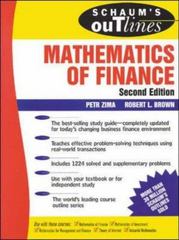


Impact on debt rating A key assumption in the analysis would be the debt rating for Wrigley, after assuming $3 billion in debt, and whether the firm could cover the resulting interest payments. Dobrynin had suggested that Chandler should assume Wrigley would borrow $3 billion at a rating between BB and B. Was a rating of BB/B likely? In that regard, Chandler gathered information on the average financial ratios associated with different debt-rating categories (Exhibit 6). Dobrynin thought that Wrigley's pretax cost of debt would be around 13%. Chandler sought to check that assumption against the capital-market information given in Exhibit 7. EBIT interest coverage (x) Funds from operations/total debt (%) Free operating cash flow/total debt (%) Return on capital (%) Operating income/sales (%) Long-term debt/capital (%) Total debt/capital, incl. short-term debt (%) Source of data: Standard & Poor's CreditStats, September 8, 2003. Investment Grade AAA AA 23.4 13.3 6.3 214.2 65.7 42.2 156.6 33.6 22.3 35.0 26.6 18.1 23.4 24.0 18.1 (1.1) 21.1 33.8 5.0 35.9 42.6 BBB 3.9 30.6 12.8 13.1 15.5 40.3 47.0 Non-Investment Grade BB B 2.2 1.0 19.7 10.4 7.3 1.5 11.5 8.0 15.4 14.7 53.6 72.6 57.7 75.1 Definitions: EBIT interest coverage divides earnings before interest and taxes (EBIT) by gross interest expense (before subtracting capitalized interest and interest income). FFO/total debt divides funds from operations (FFO) by total debt. FFO is defined as net income from continuing operations, depreciation and amortization, deferred income taxes, and other noncash items/Long-term debt + current maturities + commercial paper, and other short-term borrowings. Free operating cash flow/total debt. Free operating cash flow is defined as FFO - capital expenditures - (+) increase (decrease) in working capital (excluding changes in cash, marketable securities, and short-term debt)/Long-term debt + current maturities, commercial paper, and other short-term borrowings. Total debt/EBITDA, Long-term debt + current maturities, commercial paper, and other short-term borrowings/Adjusted earnings from continuing operations before interest, taxes, and depreciation and amortization. Return on capital. EBIT/Average of beginning of year and end of year capital, including short-term debt, current maturities, long-term debt, noncurrent deferred taxes, minority interest, and equity (common and preferred stock). Total debt/capital. Long-term debt + current maturities, commercial paper, and other short-term borrowings/Long-term debt + current maturities, commercial paper, and other short-term borrowings + shareholders' equity (including preferred stock) + minority interest. U.S. Treasury obligations 3 mos. 6 mos. Other instruments U.S. Federal Reserve Bank discount rate LIBOR (1 month) Certificates of deposit (6 month) Prime interest rates 1.730% 1.840% 1.980% 4.750% 1 yr. 2 yr. 3 yr. Yield 1.670% 1.710% 2.310% 3.160% 3.660% 4.090% 4.520% 4.860% 5.650% U.S. Treasury yield curve 5 yr. 7 yr. June 7, 2002 10 yr. 20 yr. 6% 5% 4% 3% 2% Corporate debt obligations (10 year) AAA AA A BBB BB B Yield 9.307% 9.786% 10.083% 10.894% 12.753% 14.663% 1% 0% 3 mos. 6 mos. 1 yr. 2 yr. 3 yr. 5 yr. 7 yr. 10 yr. 20 yr. Impact on debt rating A key assumption in the analysis would be the debt rating for Wrigley, after assuming $3 billion in debt, and whether the firm could cover the resulting interest payments. Dobrynin had suggested that Chandler should assume Wrigley would borrow $3 billion at a rating between BB and B. Was a rating of BB/B likely? In that regard, Chandler gathered information on the average financial ratios associated with different debt-rating categories (Exhibit 6). Dobrynin thought that Wrigley's pretax cost of debt would be around 13%. Chandler sought to check that assumption against the capital-market information given in Exhibit 7. EBIT interest coverage (x) Funds from operations/total debt (%) Free operating cash flow/total debt (%) Return on capital (%) Operating income/sales (%) Long-term debt/capital (%) Total debt/capital, incl. short-term debt (%) Source of data: Standard & Poor's CreditStats, September 8, 2003. Investment Grade AAA AA 23.4 13.3 6.3 214.2 65.7 42.2 156.6 33.6 22.3 35.0 26.6 18.1 23.4 24.0 18.1 (1.1) 21.1 33.8 5.0 35.9 42.6 BBB 3.9 30.6 12.8 13.1 15.5 40.3 47.0 Non-Investment Grade BB B 2.2 1.0 19.7 10.4 7.3 1.5 11.5 8.0 15.4 14.7 53.6 72.6 57.7 75.1 Definitions: EBIT interest coverage divides earnings before interest and taxes (EBIT) by gross interest expense (before subtracting capitalized interest and interest income). FFO/total debt divides funds from operations (FFO) by total debt. FFO is defined as net income from continuing operations, depreciation and amortization, deferred income taxes, and other noncash items/Long-term debt + current maturities + commercial paper, and other short-term borrowings. Free operating cash flow/total debt. Free operating cash flow is defined as FFO - capital expenditures - (+) increase (decrease) in working capital (excluding changes in cash, marketable securities, and short-term debt)/Long-term debt + current maturities, commercial paper, and other short-term borrowings. Total debt/EBITDA, Long-term debt + current maturities, commercial paper, and other short-term borrowings/Adjusted earnings from continuing operations before interest, taxes, and depreciation and amortization. Return on capital. EBIT/Average of beginning of year and end of year capital, including short-term debt, current maturities, long-term debt, noncurrent deferred taxes, minority interest, and equity (common and preferred stock). Total debt/capital. Long-term debt + current maturities, commercial paper, and other short-term borrowings/Long-term debt + current maturities, commercial paper, and other short-term borrowings + shareholders' equity (including preferred stock) + minority interest. U.S. Treasury obligations 3 mos. 6 mos. Other instruments U.S. Federal Reserve Bank discount rate LIBOR (1 month) Certificates of deposit (6 month) Prime interest rates 1.730% 1.840% 1.980% 4.750% 1 yr. 2 yr. 3 yr. Yield 1.670% 1.710% 2.310% 3.160% 3.660% 4.090% 4.520% 4.860% 5.650% U.S. Treasury yield curve 5 yr. 7 yr. June 7, 2002 10 yr. 20 yr. 6% 5% 4% 3% 2% Corporate debt obligations (10 year) AAA AA A BBB BB B Yield 9.307% 9.786% 10.083% 10.894% 12.753% 14.663% 1% 0% 3 mos. 6 mos. 1 yr. 2 yr. 3 yr. 5 yr. 7 yr. 10 yr. 20 yr









